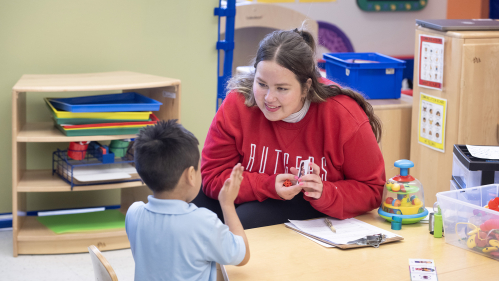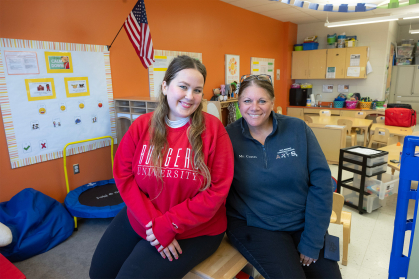Rutgers Program Trains Teachers to Provide Excellent Education to Children on the Autism Spectrum

The partnership prepares educators to work in the classroom and train others to better serve special-needs students
Rutgers junior Ara Spielman is sitting at a round table inside a New Brunswick classroom for preschoolers, encouraging a 4-year-old boy to identify letters, numbers and colors. Looking around, the boy seems distracted, but Spielman returns his focus to the lesson, using the training she has been receiving on managing the behavior of children with autism.
Spielman works about 20 hours a week at the Paul Robeson Community School for the Arts, a New Brunswick public school a few miles outside the Rutgers campus. She is earning an income while receiving on-the-job training from Ingrid Rodriguez, a Rutgers expert in behavior analysis who works alongside her in Debra Coates’s pre-kindergarten class of eight students diagnosed with autism spectrum disorder.
They are part of a Rutgers program called Scarlet Hope for Autism: The Road to Excellence in Education (SHARE) in which the university partners with two of its host communities in New Brunswick and Newark to help those districts better serve their special-needs population.
The program, which is provided at no cost to the districts, is run through the Douglass Developmental Disabilities Center in the Graduate School of Applied and Professional Psychology.
SHARE’s mission is two-fold: provide support services now and, at the same time, prepare district staff and teachers for the future with “train-the-trainer” sessions so the program will continue and grow even after Rutgers experts leave. The program provides an opportunity for Rutgers students to gain experience in the classroom, while also training existing teachers and staff.
For Spielman, a psychology major at the School of Arts and Sciences, the job has broadened her perspective to consider other positions in her field.
“Over the past few months that I've been there, I just love it,” Spielman said. “I think this may be changing the trajectory of my academic career.”
She was pursuing becoming a clinical psychologist, but she is now considering working with autistic students in some capacity.

For Coates, a veteran teacher with 35 years in the classroom, the partnership with Rutgers has offered her the opportunity to learn a new method of teaching.
At Paul Robeson school, a pre-kindergarten-through-eighth-grade school, there are 58 students on the autism spectrum receiving behavior therapy. Experts and educators in the field refer to this widely researched, used and accepted form of therapy as Applied Behavior Analysis or ABA. It is designed to help those with autism communicate better and improve learned behavior.
“I’ve been teaching for so long, there are certain things that I know being a veteran, but this was brand new for me, working in ABA program,” said Coates, who has been a special-needs teacher her entire career, working over the years with students with cerebral palsy, Down syndrome, and autism. “They are different learners and I’m open to learning new things and what works best for these kids. It’s given me a new perspective.”
The program comes at a time when the rates of autism are on the rise with about one in 31 children in the U.S. and one in 29 in New Jersey on the autism spectrum disorder, according to a recently released report by the Centers for Disease Control and Prevention.
SHARE began to take root about two years ago when, as part of Rutgers’ Strategic Priorities and Initiatives plan, the chancellor’s office in New Brunswick dedicated funds toward putting education experts into the community to help underserved districts.
Around the same time, New Brunswick district officials were planning to build an ABA program and expand the district’s special education curriculum. The timing was right when Marlene Brown and Debra Paone, co-directors of SHARE, reached out to New Brunswick, said Violet Robinson, principal of the Paul Robeson school.
“We thought the collaboration with Rutgers would help us build our staff capacity,” Robinson said.
A similar partnership that began in 2018 was already in place in the Newark school district. Though the pandemic slowed progress, Rutgers experts from SHARE are now in five classrooms at two schools in Newark: South Street and Branch Brook, which was reopened last year as a school for autism with an official celebration held Tuesday, April 29.
In Newark, the program has allowed the students to remain in their communities and receive their intensive services in-house, said Marilyn Mitchell, director of special education.
“Now these parents don’t have to travel 30 to 40 minutes from home to get to their child’s school,” Mitchell said. “They can still be a part of their community. They’re in their home district. They know they can get to school within a few minutes. Those are things that when you have young children, parents want, especially if they have a student with autism.”
As in New Brunswick, the second component of SHARE in Newark is for Rutgers experts to train district staff in ABA with the hope that they will pass the knowledge on to their colleagues. The train-the-trainer program at Newark was launched in March.
Currently, Brown and Paone are training 10 district employees in New Brunswick and Rutgers experts Jaimee White and Melisa Dennis, nine in Newark. The group meets three times a month with one session in the classroom with the students.
“Our teachers enjoy the support and the learning they are experiencing from the partnership,” Robinson said. “There is nothing like having someone alongside you teaching you in real time, especially using real situations. When we’re talking about students with autism spectrum disorder, that’s the best way to learn.”
Mitchell said the train-the-trainer component of SHARE is helping the state’s largest district plan for what’s ahead.
“You just read what the CDC said, we already know the rates will increase,” Mitchell said. “How do we prepare and what do we do? This is our preparation for when we hire new teachers.”
Iris Forde, assistant superintendent of student support services at New Brunswick schools, agreed.
“Our programs continue to grow and all the needs of our students and schools are so diverse,” Forde said. “Rutgers experts have provided us with a plethora of techniques and tools that we could apply not only in one classroom and one school, but to the entire district.”
Aside from helping its host communities – which is one of the university’s four pillars of excellence – Rutgers is also helping its own students gain workforce experience.
Kayla Lee, a senior who double majored in cognitive science and psychology and is graduating next month, said she found the experience of working in the classroom “eye-opening,” one that gave her an understanding for the jobs in the field.
The salaries for Spielman, Lee and other Rutgers students in the program are funded through grants from Rutgers Equity Alliance for Community Health, Paone said, adding that students were recruited at job fairs, through email alerts, or via Handshake, an app that connects college students and employers. The students had to interview for the job and provide references before they were put into the classrooms, Brown said.
Coates, the New Brunswick teacher, said Spielman fit right in the class.
“We have a great rapport in our classroom. I think it’s a real family. We’re all learning, and we help each other,” she said. “It’s a new beginning for us too with this partnership.”


